Author: genesisleesmith
Genesis Lee-Smith : Neighborhood 2022

Chosen Neighborhood as Text
“From Party to Peace” by Genesis Lee-Smith of Florida International University on December 11, 2022.
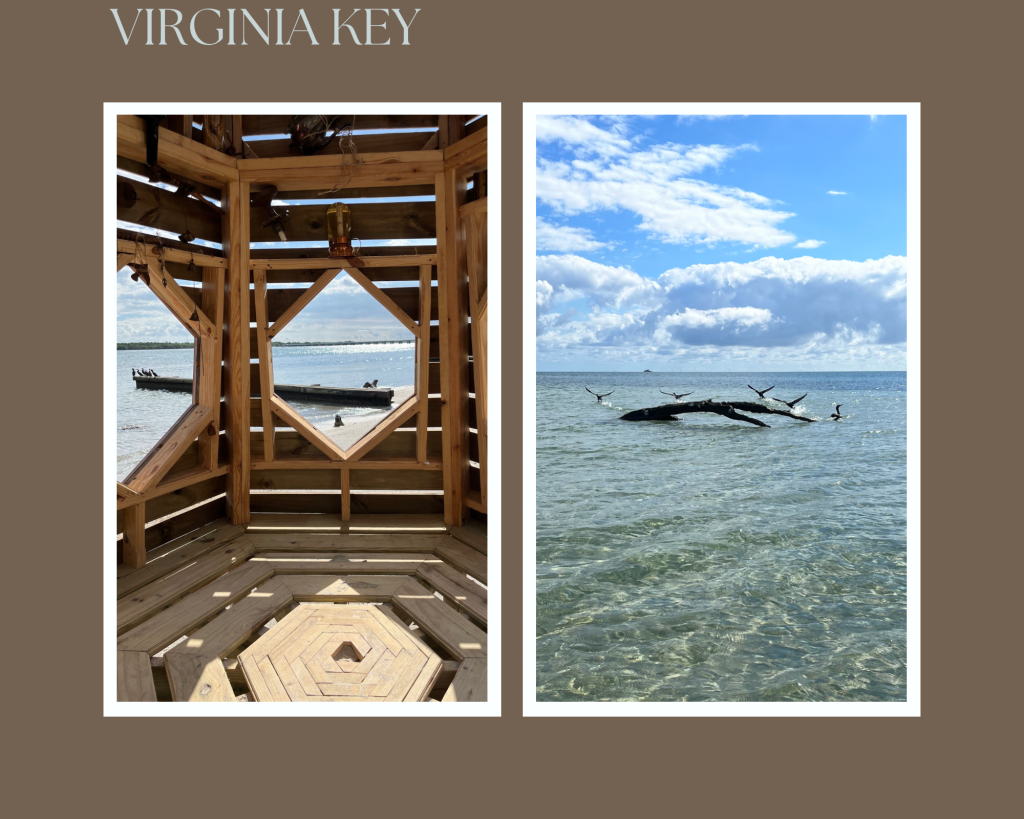
While being in the class, Miami in Miami, I learned a lot about the history of Miami. On our trip to Miami Beach, we learned about how Carl Fisher segregated the people at the beach by no longer making it a place for blacks to enjoy.
As more people began to move to Miami, blacks were pushed further and further away from the places they built. They did not have many places to call home.
However, blacks started to spend time in Virginia Key. A place that they could enjoy. It was not always like this though. Blacks fought to have this beach. They mostly hung out around “Bears Cut” which is a part of the beach. Not only were they allowed there, but it became known as a “color-only” area in 1945. People from Cuba and the Caribbean would tend to visit the beach because they felt welcome there. People were able to come in from other countries because the beach was only accessible by boat. With this information, blacks would sometimes arrive on boats in packs of a hundred people. They came in packs so that many people would be able to make it from their homes to the beach all together.
The blacks seemed to have made Virginia Key a place where there were no worries for them. They could simply enjoy the beach and the company of those around them without being in fear that they would be disturbed.
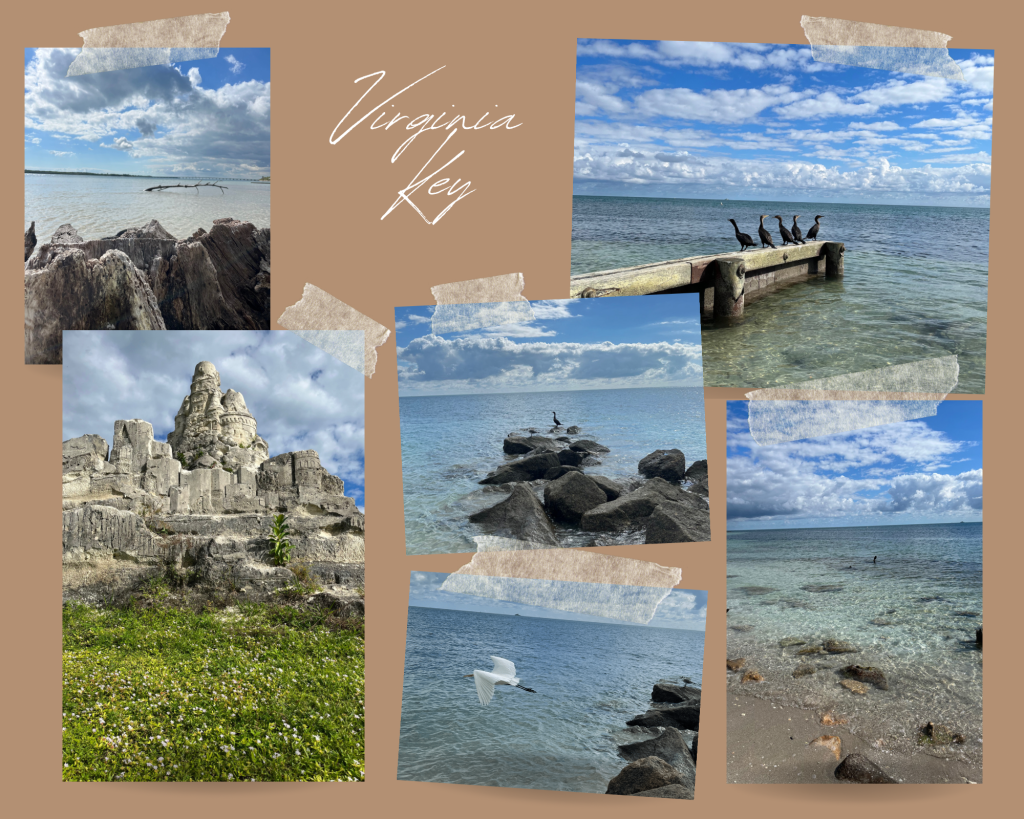
This beach was not only a place for relaxation and enjoyment, but blacks would also host religious services here. They felt free to express their praise to God in such a sacred place to them. They were able to give thanks to God for the area where they made many memories. This place was the hangout spot where everyone was welcome and where they could laugh and dance and create memories with their friends and families.
As I visited Virginia Key beach today, 76 years after the beach became a popular place for blacks, I noticed how different the beach was compared to the stories I had imagined about the beach in 1945. When I went, it was quiet. There were times when I was the only person at the section of the beach I was at. It was a Friday afternoon so I expected to see more faces. There were a few families that would come across every now and then, but it was not as busy as the other Miami beaches that I have visited. I imagine that the dynamic of the beach changed after it was closed down to the public in 1982 because of high maintenance costs and was not reopened until 2008.
However, the stillness and soothing sounds of the waves were peaceful because I was able to reflect. As I stood at the smooth shore and looked out into the clear water and watched all the birds fly around in the clear blue sky, I got to think about how Virginia Key Beach used to be different from what I was experiencing in my moments of visiting. I thought about how lively it was and remembered all of the pictures I would see of blacks in the 40s having cookouts and celebrating life. One picture that I saw while collecting my information was an old portrait of a black lifeguard in red shorts with a whistle dangling from his neck. I noticed that this picture was posted often around the beach. I saw it on signs and even stuck to almost every trashcan at the beach. I tried to find out the man’s name who was plastered in these pictures everywhere around the beach but I could not find his name. Even though we do not know his name, he is now the face of the Historic Virginia Key Beach Park.
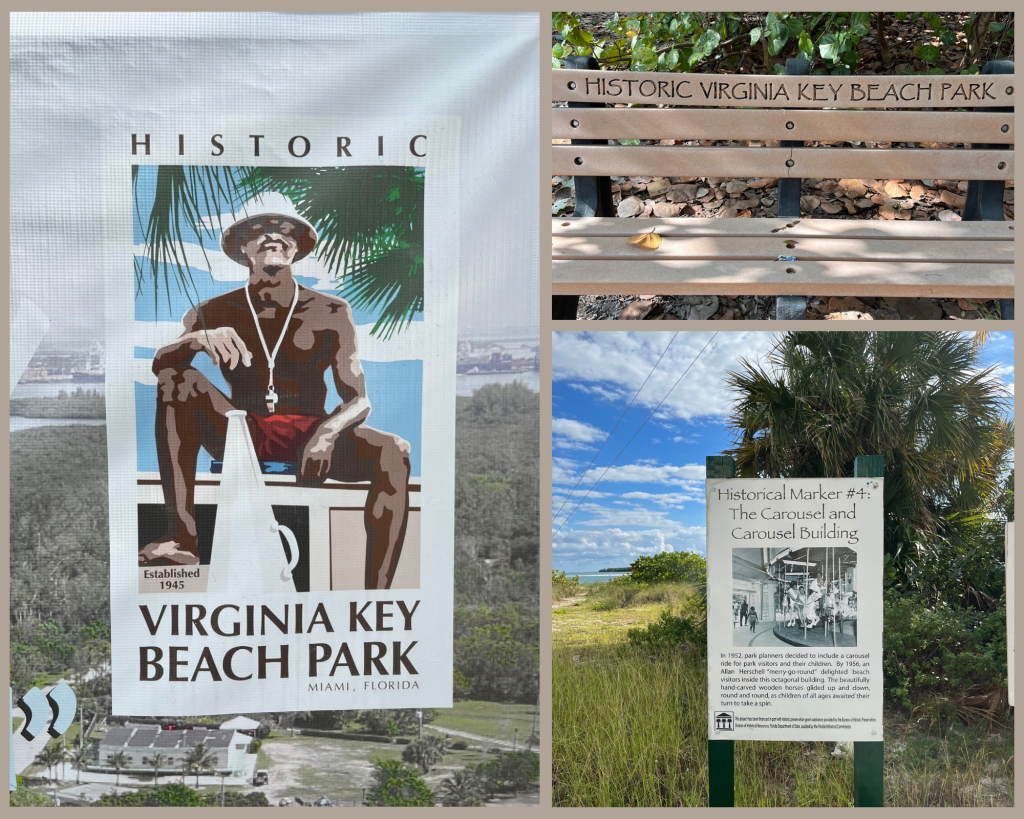
Moreover, Virginia Key Beach was one of the most beautiful clear-water beaches that I had ever been to. The line of separation between the sky and the sea at this beach was so beautiful. It was an array of different shades of blue that meshed into each other perfectly. The beauty of the beach brought me peace because I knew that the blacks truly had a joyful experience at such a beautiful beach as this.
Since Virginia Key is now a historic location, there are still many pavilions and small gathering places where the blacks would meet up at. There are still many boats and docks around which made me think about how blacks would come in large groups to enjoy this beach. If the beach had not shut down maybe it would still be as popular as it used to be, however, the stillness of the beach and its historic parts allowed me to simply reminisce on the blacks enjoying their best days in the 40s at this beach.
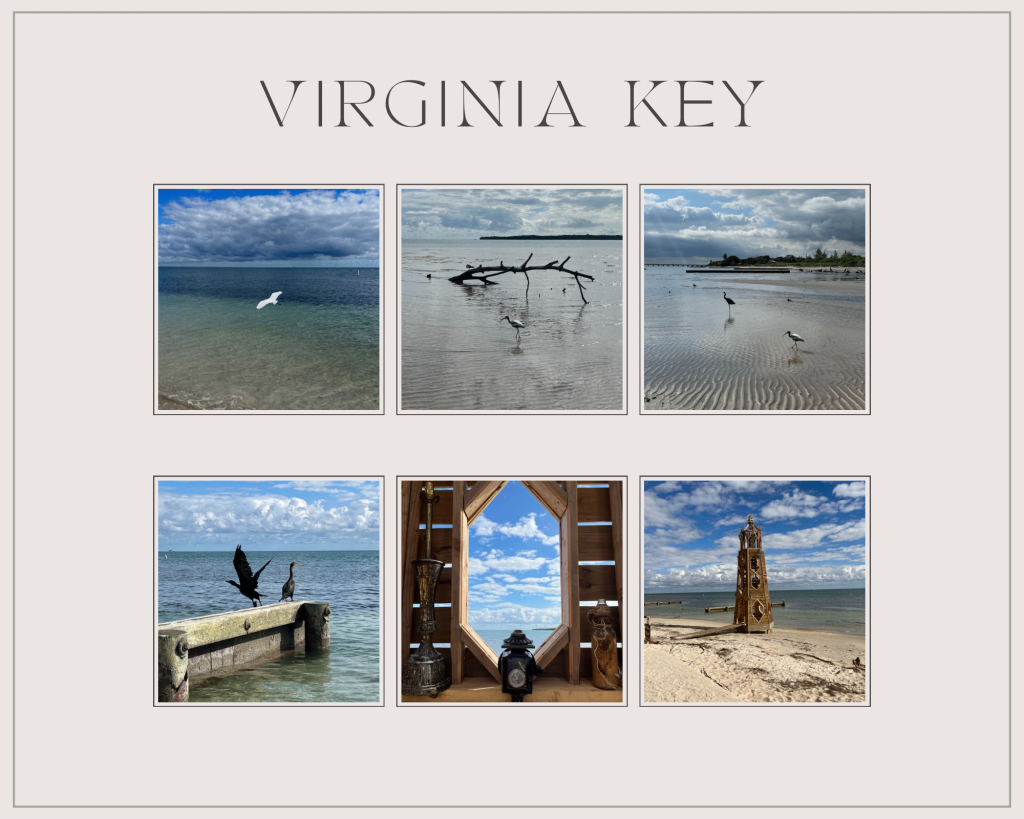
Works Cited
Our History. Historic Virginia Key Beach Park, https://virginiakeybeachpark.net/our-history/.
White Sand, Black Beach: The Black History of Virginia Key . The New Tropic, https://thenewtropic.com/virginia-key-beach/.
Genesis Lee-Smith: Miami as Text 2022-2023

Downtown Miami as Text
“Why Not Allow Love?” by Genesis Lee-Smith of Florida International University on August 31, 2022.

The lives of William Wagner and his wife Eveline Aimar touched my heart based on their love for each other and those around them. Their kindness and love broke boundaries and walls for others. Their love painted life in such a beautiful way because they did not get caught up in the opinions of those who tried to ban their love.
William Wagner, a man of fair skin, was from Germany. He effortlessly chose love for Eveline Aimar, a light brown woman from Creole. No matter the laws or boundaries of that time period, here in the city now known as Miami, they both chose to love rather than discriminate or get caught up in what other people thought. They chose love by quieting out the negative voices of those around them.
Together they raised three kids, one daughter that they shared and two of Eveline’s sons. They were known to be a family that was willing to open their doors and let people in. The Wagner family did not disguise their odds of love by hiding away or removing themselves from others. Instead, they opened their home to those around them. They willingly opened their doors no matter the consequences that they were bound to face.
One story about the loving Wagner family that stood out to me was the story of them inviting some of the Indians over to their place for a meal. This story stood out to me because, during this period in the 1800’s, most people groups mingled within themselves. This image of the Wagner family, a white German man, a light skin Creole woman, a mixed daughter, two Creole boys, and Indians paints a diverse color palette of humans simply enjoying each other’s company without getting caught up in race or things that do not matter. They were humans simply enjoying the company of other humans. There was not any pride of any other race in this situation. They just welcomed everyone fully.
Whenever I hear stories like this, it inspires me to stand on what I believe instead of letting those around me try to switch my views. The Wagner’s believed in love and chose love over anything else. Their love never caused harm to anyone else even though it caused harm to them. They faced discrimination and their son was murdered because of the hate people had toward the Wagner family all because they chose to love outside of their race.
This story also touched my heart because I grew up in a mixed household from the age of three. My stepdad is Puerto Rican with fair skin and my man is light skin brown. I also have two mixed brothers. Years after the Wagner story, people still say ignorant things now. Not because they are trying to be offensive, but simply because they are used to hanging around only people that look like them. Some cultures are different from others and it is beautiful to see how other cultures do some aspects of life differently and how some cultures are similar.
I can not imagine growing up in my family during the time of the Wagner’s. I think that life would be completely different. It makes me wonder if my parents would still choose love at that time. Would they be willing to put their lives and my siblings’ life on the line so that their story of love could inspire others later on in life?
Wagner’s bravery to choose love and quiet the voices around them left a legacy that impacted my life many years later. Their love story was not just created for them but created for those to later be impacted by their story.
Overtown as Text
“Disrupted Peace” by Genesis Lee-Smith of Florida International University on September 25, 2022.

As I walk through the history of Overtown, I imagine the things that blacks found their hope in during the ’40s, ’50s, and ’60s. Being a minority race, they had to find something that brought them joy and peace with all the ruckus and racism surrounding their everyday lives. I picture them in Overtown at Lyric theater excited to see performers and excited to listen to music they loved. I picture them smiling, dancing, and singing along as a way to block out the terror of the rest of the world for just a moment. I picture them in church fully relying on God and singing hymns of praise. I picture them in these moments full of joy. Able to ignore the damaged world for just a moment.
Once I heard that the peace of blacks was destroyed in Overtown because of the construction of the two interstates of I-95 and I-395, it shattered my heart. It shattered my heart because all the places that brought them joy and peace were purposely interrupted by the busy streets of the newly constructed interstates. Those interstates separated blacks from each other and cut a line through their neighborhoods. They cut a line through what they called home. It was another way to purposely separate people. With constant noise and pollution, it became hard for blacks to live in Overtown. There were already limits on where they could live and enjoy life, but the construction of the interstate kept stripping away their communities.
As we walked around Overtown and stood outside of churches, I could hear the constant noise from the busyness of the streets. Most of the noise from the interstate came from I-95 located directly by the church “Mount Zion.” There were cars honking. People revving their engines. People blaring music. Just constant noise to disrupt what was once known as a town where blacks were forced to go and could collectively live together.
As I heard Wendell, the man who showed us Greater Bethel, explain how the church was stripped apart because of the construction in Overtown, it really broke my heart. It was mind-blowing to me that that church had speakers like Martin Luther King Jr. and Malcolm X speak at the church. It is mind-blowing that the room used to be packed all the way to the balcony. Now, it is just a small local church that has decreased in size because of construction. This story hit home to me the most because I know that some people, especially blacks during that time, attended church because they could not find hope in the cruel world. They ran to Jesus because their hope was in Him. The church was a place of communion for them. The church was home. Yet, it was stripped apart. The construction of the interstates destroyed homes and made it difficult for them to actually focus with all of the outside noise.
To this day, Overtown is still being destroyed. Overtown is still being split apart. Condominiums are being built right in the heart of what some people know as home.
Even though, with all of the craziness of the world and the deconstruction of Overtown by the construction of interstates, I hope that blacks at the time of construction were still able to find a place to express their joy and peace. I hope that they still found a place to smile, sing, and dance in peace. I hope that they still found a place to worship God. Even though their homes and places, temporary things, were destroyed, I hope they still found a place of communion. Their homes and everything else could be taken away, but who they were deep down inside could not. I hope that the joy and peace they had while singing, dancing, and praising, never left them.
Biscayne Bay / Chicken Key as Text
“Defeating Debris” by Genesis Lee-Smith of Florida International University on October 16, 2022.

As we students traveled about a mile from the Deering Estate to Chicken Key, I saw the beauty of what was around me. I saw the flourishing palm trees, the bright green grass, the crystal blue sky, and more. I saw the manatees and fish that swam around the water. The water that carried us to the island in our canoes and kayaks.
As I continued to look at the scenery around me, it was not hard to notice how murky and dark brown the water was. It started to strip away from the beauty that was surrounding me because when I saw the sea animals in the water that were swimming around, I started to think about how we were going to pick up trash that was left behind in their habitat.
Before going on the trip, I knew that we were going to collect trash in the water and on the island. However, I was not expecting to collect a lot of trash because I did not know how I could find enough trash from a body of water that large. How could my classmates and I make an impact when we were faced with finding trash in the water and trash that washed up on shore in that large body of water?
To my surprise, my classmates and I found numerous amounts of trash. I had green sandbags that were overflowing with trash. I was in shock at all of the items that I found that had washed up on shore and that were just left on Chicken Key. There were nearly endless amounts of waste. Finding trash was like finding the jackpot because there was so much of it everywhere that I was not expecting to see. We had so much trash that the cargo bed on the pickup truck could not even carry all of it. So much trash that it unbalanced the weight of the canoes and made it more difficult to get back to the Deering Estate.
Most of the trash was marine debris. There were pieces of plastic such as water bottles and containers. There were shoes, hats, other clothing items, alcohol bottles, couch cushions, pieces of metal, and more. I saw crabs crawling around in their habitat that was invaded by trash from human hands. I saw the manatees in the water swimming around in the water that is also invaded by trash. Humans have become desensitized to leaving numerous amounts of trash in water without fully thinking or caring about how it could negatively impact the living breathing animals and plants in the water.
The same murky water that got us from Deering Estate to Chicken Key is the same water that used to be freshwater coming in from the Everglades. That same freshwater that gave sea animals and plants a place to flourish and grow. It was made just right for them to survive.
Now, due to the debris and nutrients in the water, many plants, such as seagrass are dying. They are having trouble surviving in a habitat that was not created to be filled with trash. The loss of seagrass affects the food that some sea animals eat which also affects their ability to survive. Coral reefs and mangrove trees that used to line the water and deposit food into the water have also been destroyed due to the carelessness of people putting trash in the water and leaving it on shore.
Overall, going on this trip has opened my eyes to just how much trash is actually in our surrounding water. I have always loved the water such as oceans and bays because, in the water, the sea animals have their own world that actually takes up more space than the land we get as humans. I have always been fascinated by the water, but never noticed how much it was being destroyed until it started to wash up on shore. I wish that everyone could experience a day like this so they could see just how much of an impact their “little piece of trash” has on the environment.
Vizcaya as Text
“Celebrating People and Culture…Sometimes” by Genesis Lee-Smith of Florida International University on October 23, 2022.

This specific trip was one of the trips I was most looking forward to participating in. When I moved to Miami this past summer, I had always driven by Vizcaya in curiosity, wondering why this was such a popular museum. I would eagerly look up pictures of the museum on my phone and admire its beauty digitally. However, when I arrived at Vizcaya, I was reminded that sometimes pictures do not do justice to what is actually seen in the physical. The pictures I saw did not even compare to how beautiful and unique Vizcaya truly is. I went into Vizcaya not knowing anything about it other than knowing that it is a beautiful garden and museum loved by the people of Miami.
As I was walking around, I was taken aback by the European design of this house. I could see how much James Deering admired Europe. He had several talented artists such as
Paul Chalfin, Duane Brant, Joseph Defer, and more, come in to create his European-style home. He even had certain European decor and items shipped to Miami to add to the effects of his home. A home that is still admired by many people today even though the house was finished in the early 1900s.
As I learned more about the individual art pieces that highlighted Deering’s character and as I started to take in his creativity, I realized just how much Deering admired the beauty of another culture. The culture of Europe. He praised Europeans and their art, however, neglected another culture and people group, the Bahamians. During the time his house was built, black laborers were given low pay and were forced to work in poor working conditions. Deering had respect for other cultures and people groups, other than for the ones that put together his timeless home.
Hearing about who Deering was as a person started to taint my view of Vizcaya. The Vizcaya that I had been driving by almost every day this summer, excited to see.
I went to Vizcaya and learned about how Deering was known as the wealthiest man in Miami who hired over 1000 people to contribute to the building of his home. Yet, with all of his fortune, he knew that workers who helped contribute to the building of his home were paid poorly. He admired the culture of some people, Europeans, but let others, black laborers, get treated poorly due to societal standards. He was focused on the culture of other places in the world but neglected what was happening to the culture and people group right before his eyes. The people that made his beautiful home. The home that was designed specifically to Deering’s likeness.
It seems that all of his fame and fortune never changed his heart. Rather, he just neglected the care of those creating his home by having laborers forced to create a place of enjoyment and pleasure for himself. Deering had them create a place of enjoyment and pleasure knowing that the laborers most likely did not have any. He had them celebrating and building upon a culture in another continent, Europe, while their own culture and people group was knowingly and intentionally looked down upon by others like Deering.
South Beach as Text
“Don’t Destroy Deco” by Genesis Lee-Smith of Florida International University on November 6, 2022.

South Beach. A place for nightlife with music and retro lights that line the side of the street across the beach. South Beach. An attraction for college spring breakers to celebrate their time off of school. South Beach. A place where families come day by day to enjoy the beach, a bike ride, and/or a stroll in their floppy sun hats and sunglasses. South Beach. A place with busy streets to show how many different kinds of people are attracted to this area of Miami.
Before South Beach was the well-known attraction that it is today, it was like any other ordinary neighborhood. People went to the beach without worrying about a crowd. Families went out to eat at night without the thought of how many tourists they may run into.
Even with all of the changes over the years, one thing about South Beach that never changed was the art. Walking around South Beach now, I saw unique buildings that were built in the 1920s that are still up today. I saw architecture that was inspired by the wild color-filled imagination and unique qualities of the designers. Their imagination led them to create bright-colored buildings that look like boats and buildings that were inspired by the tomb of King Tut.
Art is a piece of South Beach that adds to its uniqueness. It makes it unique in a way because of its preserved history. Even with all of the change and popularity of the beach over the years, the South Beach that is admired today still has hints of the less popular South Beach that was enjoyed by families in the 1920s. There are other places in Miami that did not preserve some of its histories, however, South Beach is a place that has preserved history, thanks to Barbara Baer.
Barbara Baer Capitman was an unshakeable female preservationist who fought to keep South Beach as South Beach. With her last name sounding similar to “captain”, she captained her way to make South Beach’s Art Deco neighborhood the nation’s first 20th-century National Historic District.
Taking her circumstances into mind as a woman, Barbara faced many highs and lows to fight for what she thought was right. She not only fought to keep South Beach Art Deco as a place to reminisce for the older generation, but she kept it as a place for new generations to see for themselves. She did not let Art Deco just become a memory, but a place where people of different generations can continue to make memories and capture pictures in the same spots.
Capitman’s bravery led to the beginning of many things including the start of the Miami Preservation League in 1976. This organization actively works to protect the history of Art Deco and other places in Miami.
Because of her passion and determination, Capitman fought for preservation so that I could go to South Beach and admire the rule of three, relief art, and the eyebrows of the buildings. Art that is still considered not normal today. She preserved the creativity of the artists who were passionate about their work. She preserved the memories that linger on the streets of people who were in Miami in the early days. She preserved places where important moments may have been captured for people and families back then.
Deering Estate as Text
“Falling in Love with Nature” by Genesis Lee-Smith of Florida International University on November 27, 2022.
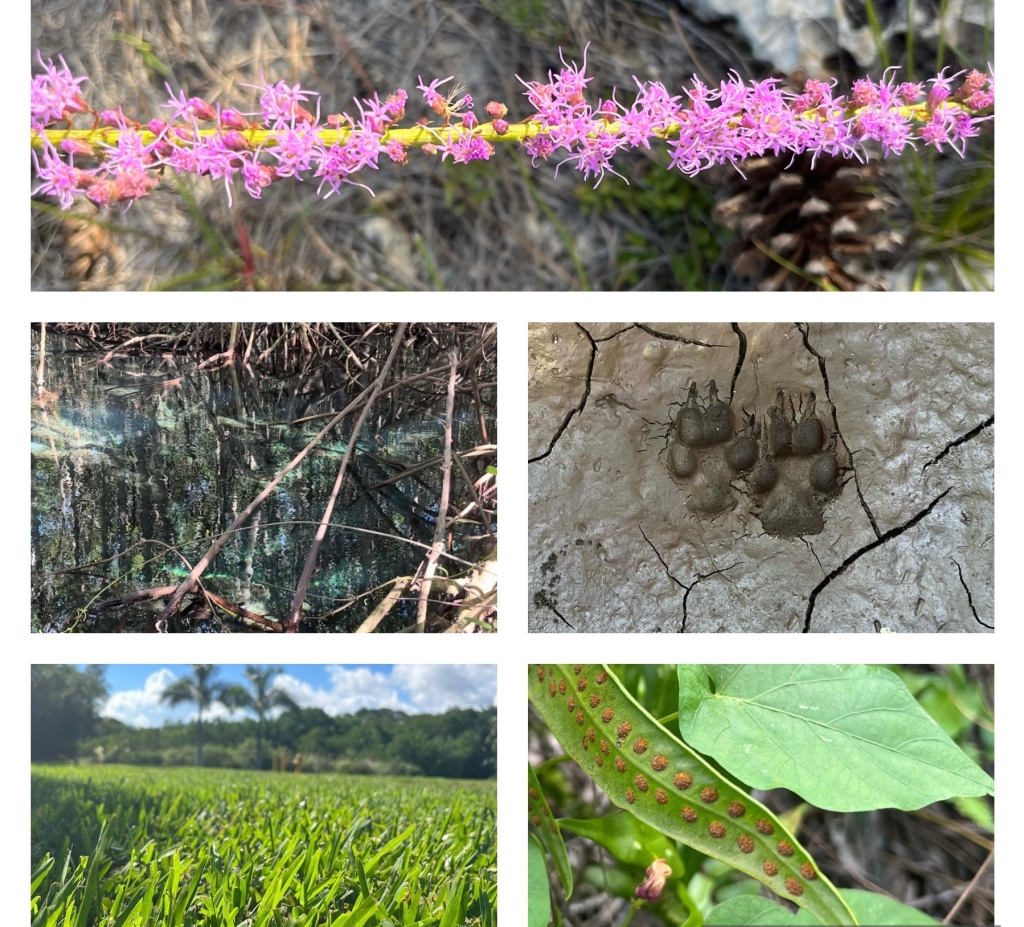
Nature has always been something that I admire. The beauty and diversity of nature gets overlooked often because we humans are so used to seeing it in our everyday lives. However, if you stop and look at nature, your eyes will be opened to see just how much detail is on this planet of Earth.
My dad always laughs at me when I often bring up my fascination with nature, especially when I begin to explain that blades of grass are my favorite part of nature. He thinks it’s humorous because blades of grass are “simple” and “boring”. Yet, the simplicity and boredom of grass is what intrigues me. Blades of grass are something so simple, yet no human has ever created the ‘’simplicity” of the miles and miles of grass that this planet holds. They can modify it, but can not make it. As far as I know, no human has ever created even the perfect soft blade of grass that most of us walk on every single day. It is simple, yet we do not know the ingredients of something as simple as grass.
Along the trails of grass and dirt, I saw new parts of nature at the Deering Estate that I had not seen before. Nature that I had never seen in my twenty years of life. One thing that particularly attracted me was the fresh clear water that I saw right before my eyes in the middle of the forest for the first time. The freshwater sat above loads of dirt and was surrounded by hundreds of windy trees, yet, it was so pure. It separated itself from the dark brown dirt of nature as oil separates itself from water. No matter how many grains of dirt may have flown into the water during the terrible hurricanes and rainstorms of Miami, the freshwater springs always clean themselves up.
The freshwater springs house fish and have been seen at the Deering Estate for centuries still unaffected by all of the dirt surrounding it.
As I continued to walk around the freshwater and dodge the poison ivy at the estate, I saw Solution Holes that caught my attention. Solution Holes are deep holes in nature that have the solution to add extra protection to hammocks. This is caused by limestone erosion.
I was captivated by this because usually something like erosion is seen as death since the rocks are unforming and going back into the dirt. They can not survive as rocks anymore. However, when the rocks face abrasion, they are able to cave into these holes that provide something new and useful. They take on a new form in order to protect the hardwood hammocks.
Once the holes are created, animals, like the American alligator, will move to the Solution Hole, making the hole its home.
From grass to freshwater, to solution holes, nature is in the constant process of providing for its other parts and showing off its beauty to humans and animals. It is in the continuous cycle of showing new parts of itself and revealing just how much it is capable of.
Rubell Museum as Text
“Communication Without Words” by Genesis Lee-Smith of Florida International University on December 4, 2022.
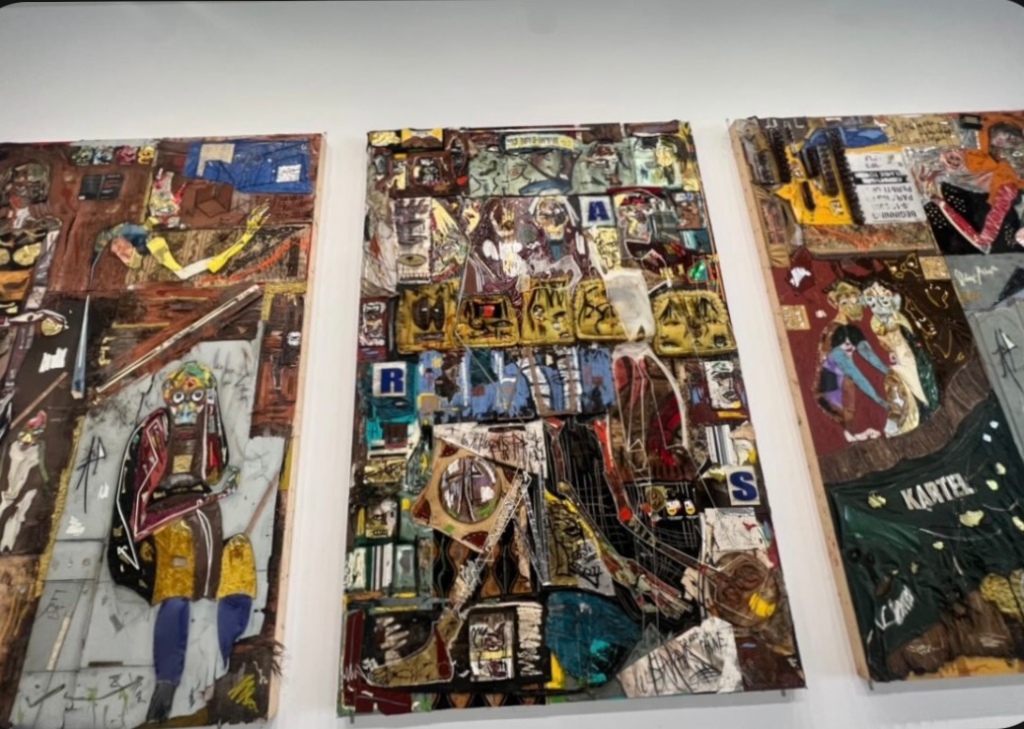
Art has always been a way for people to express themselves and share their vulnerability with the world. There are various forms of art that appeal to our senses. There is the art of music that appeals to our sense of sound. The art of dance that appeals to our sense of touch. Then, there is physical art such as paintings or sculptures that appeal to our sense of sight. This sense of art is just as powerful as the rest. It is powerful because visuals can have tremendous effects on us. We can see something that can completely change our lives and take us to memories that release serotonin or we could see something that could completely traumatize us. Visual art is compelling and a way for people to portray how they feel or express their beliefs without being vocal. It is a form of communication without words.
At the Rubell Museum, Don and Mera have intentionally dedicated over 50 years to understanding artists and allowing them to showcase their work. They have collected art from thousands of different artists and thousands of different pieces of someone’s story given to them in the form of art.
The art displayed at the museum is contemporary art. This means that the art is “present-day” art. I believe that contemporary art can be some of the most enticing art because it speaks to the world today. When people paint a picture of how they are feeling about the current state of the world, it allows us, viewers, to physically see that picture and understand it. It is fitting for our time period to relate to and interpret social issues that we see today or have seen in our lifetime. It brings awareness. It also humanizes us by making us see that we all may be seeing the same issue even if many are not vocal about it. It brings us to a place of understanding and highlights what we see and go through in the human experience.
Contemporary art, such as the art at the Rubell museum has bright colors to enhance our visuals. I believe that the bold colors and uniqueness make it easier for the artists to engrave their images in our brains so we can remember their message. I am more likely to remember something that stands out rather than a piece of art that may be more neutral.
These bright colors and enhancing visuals allow me to replay my memories of seeing the art for the first time over and over again in my head making it easy to remember specifically what I saw.
The fascinating thing about the visuals of contemporary art is that it can be seen as trendy since it is current art. There can be a painting of someone dressed in present-day clothing, however, the meaning of the painting can be much deeper than a simple man or woman dressed in current clothes. I believe that is why the Rubell’s dedicated much time to understanding the art and the artists. They found artists who could take something that may seem like an ordinary picture but have someone’s life story attached to it.
The visuals of contemporary art are powerful and tell us stories to spread a message. Visual present-day art should not be overlooked. The Rubell’s give many people chances to release their art and share it with the world in order to make an impact with their talents.
Miami Art Week as Text
“Stretching to Fit the Canvas” by Genesis Lee-Smith of Florida International University on December 11, 2022.

“Untitled Contemporary Art” photos taken by Genesis Lee-Smith // CC by 4.0 / The picture on the bottom right corner is “Tait Theta-Talk to Me Father” by Turiya Magadlela.
During Miami Art Week, my class and I were able to attend “Untitled Art” at Miami Beach. “Untitled Art” is an event held in a custom-designed tent where artists from all over the globe are able to show and sell their art. As a student who is not an art major and has only lived in Miami for less than a year, Miami Art Week was something new to me. I did not go in with any expectations and did not know what I would learn about or see while I was there. However, I was blown away by some of the stories behind the art.
One piece of art that really caught my eye was the piece “Tati-Theta – Talk to Me Father” created by Turiya Magadlela who is based in South Africa. This art piece was displayed at the Kates-Ferri Projects booth, His(Her)tory. When I first saw this piece, I saw it simply as physical art. I did not think about there being any specific meaning behind it since I did not know about any of the pieces before going. But, when I heard the story behind this piece, I was amazed at the creativity that went into it.
The meaning of this piece is to show how women have to try to fit themselves into society. One thing that Kates, of Kates-Ferri Projects, highlighted was that the pantyhose were stretched out on a square canvas in order to show how women have to stretch themselves out to fit into a man’s society. This piece also highlights how women are unfairly treated in Africa by the men there and by people in high power in first-world countries. It speaks on the lack of inequality based on age, race, and capitalism.
This piece captivated my attention because there is such an impactful story based around this piece of art. Magadlela is based in South Africa, yet her story is reaching America and reaching females here who may feel unplaced in society. I have only grown up in America and have never been out of the country, so this piece was impactful to me because it gave me a taste of what Magadlela sees often in her life outside of America.
Oftentimes, people overlook the heartbreaking situations that are happening in the world around us. People have seemed to lose focus on what is actually important by working toward a life to simply impress others when we should be focusing on the fact that people in other parts of the world and even here in America are also struggling. We live in a distracted society because most of the time we see people living their best lives on social media just to pass time when we could be making better of our time by using our platforms to make an impact on others and bringing about awareness to serious issues. We should be educated about what goes on in our own country and the countries around us rather than being consumed daily by unimportant things.
Magadlela’s piece really stood out to me because she stepped out in boldness by bringing awareness to how women are treated and how the people in Africa are treated. She used her piece to bring about awareness to issues that need to change. She did it in a way by taking something as simple as pantyhoses and attaching a powerful memorable story to it.
My Miami Final Reflection as Text
“Connecting Miami to its History” by Genesis Lee-Smith of Florida International University on December 11, 2022.
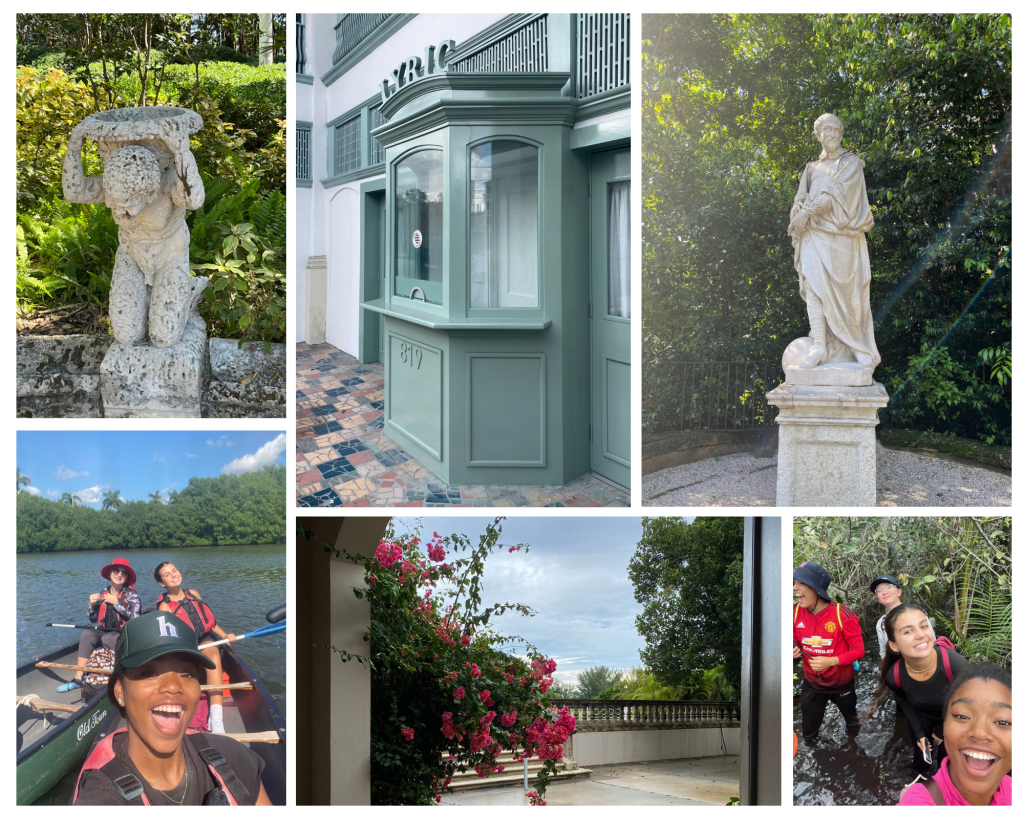
Oftentimes, when I visit different cities in the U.S., I correlate the city with its history. When I visit Atlanta, less than an hour away from my hometown, I reminisce on all of the field trips I used to take to Martin Luther King’s childhood home. When I would visit Saint Augustine every other year with my friends, I would always think of Ponce De Leon and his history in Saint Augustine. These are both historical towns that show their history through different monuments and statues.
Before moving to Miami six months ago, I did not have any history to correlate with Miami. I knew Miami as a vacation spot. A party city. A beach-town. A place where many well-known people tend to enjoy their time off.
Before taking this class, I was not sure about how much history I could learn about Miami since the history of Atlanta, near my hometown, was so well-known worldwide. I thought that Miami’s history was not seen as important since I did not know any history surrounding it.
To my surprise, when I took this class, I learned so much about the important and relevant history of Miami. Some of my favorite moments were seeing how surprised my Miami native friends were when they would find out the history of their hometown that they had never learned about in school. I signed up for class when I first moved to Miami so that I could be introduced to Miami in the most educated way.
During our class times, we visited many places and learned a lot in our almost six-hour class periods. I had toured so much of Miami, however, there were three specific stories that really stood out to me and will most likely stay with me forever. There were a lot of impactful stories that I had learned about, but these three specifically had the biggest impact on me.
The first story was about the Wagners. I admired how pure and genuine their love for each other and others was. Their story radiated throughout history by being told hundreds of years later. In a world that contains a lot of brutal history, their story was heartwarming. I believe that they died knowing that their love won over all of the hate that was thrown at them.
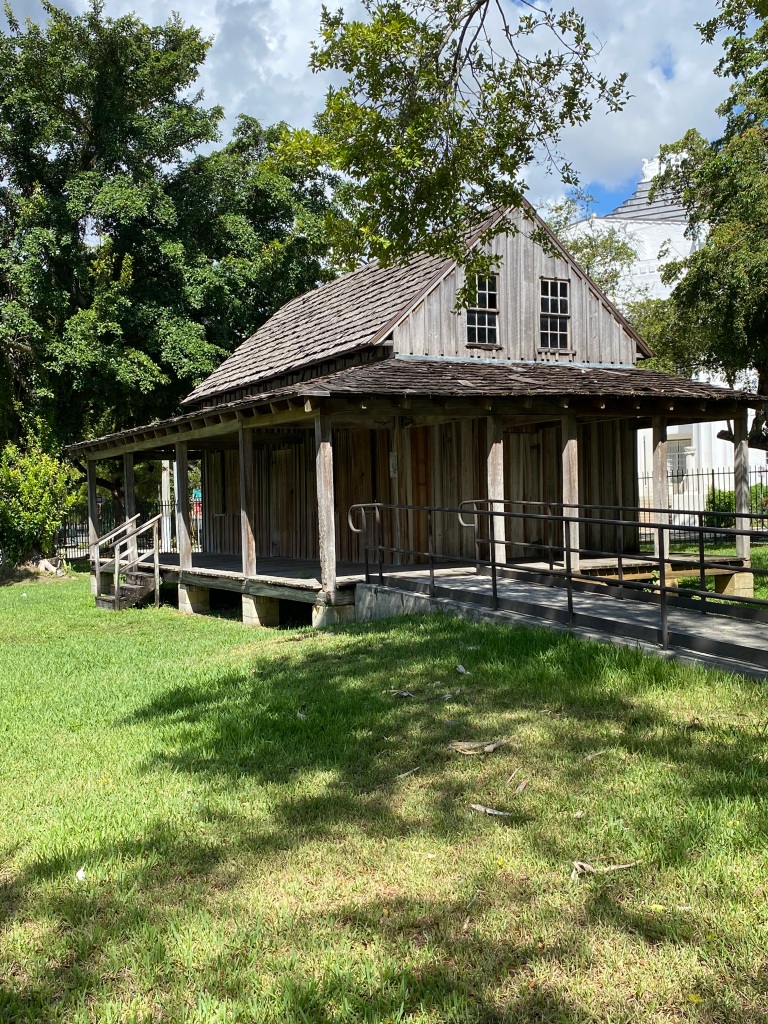
My second favorite story was learning about Julia Tuttle and how she contributed to the start of Miami. Her story should be elaborated more in schools. Tuttle, as a woman, contributed to one of the most popular cities in the world. Tuttle, the Mother of Miami brought people to Miami. She was a woman leader in a time when women were not seen as leaders. She was a businesswoman and did not let men or society at the time stop her from discovering new places.

My final favorite story was learning about Barber Baer Capitman. Her story really stuck with me because, like Julia Tuttle’s story, it was a story of a woman showing bravery. She fought to keep her hometown as Art Deco. She did not want people to destroy it. She wanted to preserve history. Her preservation is now a part of Miami Art week where, annually, people from all over the world come to Miami to see and appreciate art.
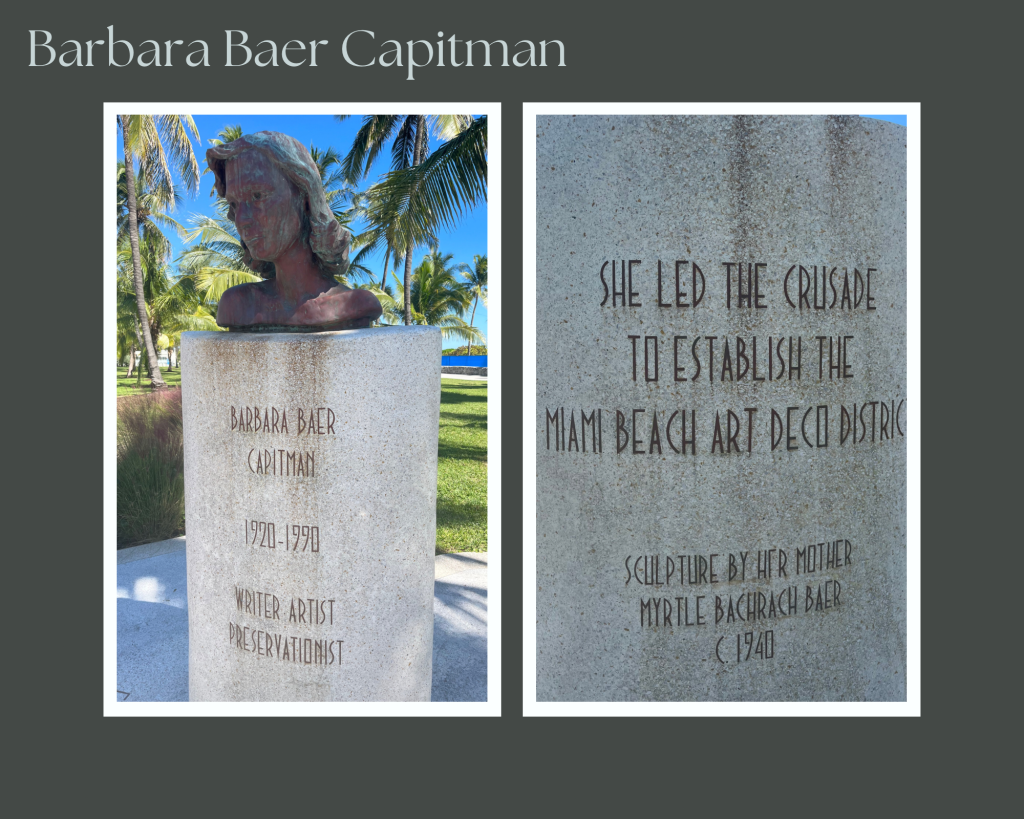
These specific stories stuck out to me because these people fought and stood for what they believed in no matter what was thrown at them. The Wagners did not let hate or racism tear them apart. Julia Tuttle did not let men talk her out of exploring and being a businesswoman. Barbara Baer Capitman fought to preserve her city when others thought otherwise. These are history-defining moments because these people did not follow along with what the world or the crowd said. They stood firm on their beliefs. It can be hard to stand firm on your beliefs when everyone around you thinks otherwise, however, these people fought with their priorities and dreams in mind. I was inspired by each one of their stories of bravery and passion for who and what they loved.
Overall, I truly enjoyed this class. I got to see much of Miami in my first couple of months of living here. I liked being able to visit different neighborhoods and different parts of this big city. I liked that I got to see different cultures and different types of people. I admired it because it is a lot different than the small town in Georgia where I grew up. Being in the city versus living in the suburbs makes a big difference for me so I got to see so many parts of the city through this class. I also appreciated how the class was not just lecturing but we actually got to travel and see important memories from history for ourselves. Being able to walk in the place of the Tequestas, being able to walk where James Deering once walked and being able to walk where the Wagners once walked, made it more real to me and will better help me retain the information that I learned. Now, when I think of Miami, I can correlate its history to it just like I do with other cities.